We make our ideas and our knowledge available for a larger public in our books. They are easy to read, also understandable for teens as well as elderly people. The essential statements are marked in a box and illustrated with very informative photographs
Advantages of appropriate care:
- Living habitat according to the needs of the animals
- Companions of the same species
- Interesting social behaviour
- More fun and interesting for the owners
- Prevention of most illnesses
- Longer life
|
They must NEVER be kept alone. The most important point is that they all are group animals.They live in families which they never leave.Everything is done together. They have a very intensive and complex social behaviour. There must also be sufficient space to satisfy their enormous urge for movement as well as to enable them to engage in their social behaviour. Besides that, every animal must be able to retire into a shelter or hiding place. They are flight animals and have no possibility to defend themselves. In case of danger, they flee into a shelter. |
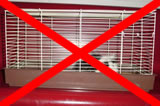 |
|
|
Eating is not just food intake, eating is a social event, also for animals. It is a very important occupation. The longer the meals last, the better. We have to organise the feeding to occupy the animals. Sometimes we can hide some greens or goodies, but don’t forget: They should not have to work for basic food. Changes in food are to be made gradually to enable the bacterial flora to adapt (health is no coincidence). The feeding time is also the time of observation. Then the animals can be monitored: Do all of them come to eat, is there a change in behaviour etc. Any change of behaviour is an alarm sign. It is a pleasure to observe happy animals in a habitat they like. |
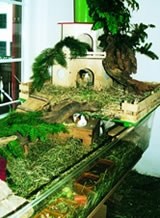 |
|
|
In captivity, we can only provide an appropriate environment to a certain extent. That is why occupation and stimulation are so essential. Boredom is deadly. More stimulation means rearranging the run with natural materials at least once a week |
 |
|
A home for the animals |
||
|
Not only the size of a run is important, but also the furnishings. With a lot of natural items you can find outdoors, you can create a habitat for these animals. Very important components are hiding places, a feeding place, gnawing materials. Indoors: Even indoors we must try create a habitat as close to nature as possible. |
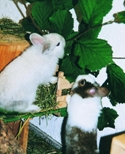 |
|
|
Commercial vivariums are available |
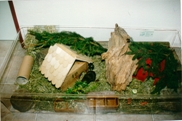 |
|
|
A suitable habitat can easily be constructed by using boards and a plastified tablecloth underneath |
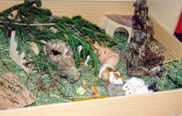 |
|
|
Because of their urge to move and to dig, rabbits are unsuitable for indoor care. |
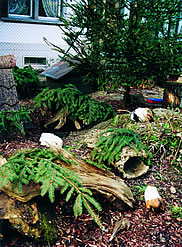 |
|
|
Outdoors: These animals can be kept outdoors, even in winter. But it has to be done properly. Outdoor keeping is very sophisticated and has to be planned very carefully. Never place a conventional cage outside. The animals will not survive in winter or in the heat. The run has to be predator proof and guarantee that the rabbits can’t dig a way out. If you are willing to keep them in such a sophisticated way it will be immensely rewarding. If not, the experiment will end in a disaster. Most important: Don’t put the animals out of sight somewhere to get them out of the way. That would end fatally, because they will be looked after even less, and will not live very long. |
Health control:
In earlier times it was said that an ill rabbit or guinea pig was a dead animal. This must not be true. As they are flight animals, they try to hide injuries or illness from predators. In other words, they just sit and don’t show anything. We have developed a simple checklist which should be followed weekly for guinea pigs, every 2-3 weeks for rabbits. The sooner you realise that something is wrong, the better the chance for recovery.
Checklist for health control:
- Weight control and recording. Long before any signs of discomfort become obvious, a slight weight loss occurrs. The weight has to be meassured on a regular base, we suggest weekly. It is important to record the results to be able to follow fluctuation. Two consecutive weight losses mean it needs a visit to the vet’s.
- Fur control. We search for hair loss, alterations in the fur and for parasites.
- Claws control. If the claws are not worn down enough, they begin to curl. This forces the toe into an unnatural position which can lead to joint problems.
- Anus control. Both urinary odour and diarrhoea have to be shown to a veterinarian.
- Incisors’ control (tooth problem): The incisors have to be symmetrical and horizontally sloped. Any asymmetry or a slope on the surface have to be examined by a veterinarian.